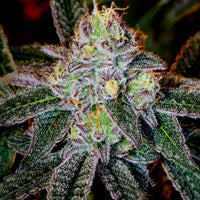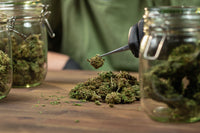Recent Posts
-

-
 Smoking Hemp Flower: A Beginners GuideMay 6, 2024
Smoking Hemp Flower: A Beginners GuideMay 6, 2024 -
 Strain Spotlight: Ice Cream CakeApril 23, 2024
Strain Spotlight: Ice Cream CakeApril 23, 2024 -
 Is THCA Legal?April 23, 2024
Is THCA Legal?April 23, 2024 -
 What is THCA Flower?April 16, 2024
What is THCA Flower?April 16, 2024

Why is my CBD Distillate Dark?
By Zero Point
Cannabidiol, or CBD, has surged in popularity over the last few years, finding its way into a myriad of products ranging from therapeutic oils to cosmetic items. Among the various forms of CBD available, CBD distillate stands out for its purity and potency. However, one aspect of CBD distillate that often perplexes both consumers and manufacturers is the variation in its color. While a light golden hue is typically associated with high quality, darker shades of CBD distillate can lead to concerns regarding its efficacy and safety. This blog post delves into the reasons behind the dark coloration of some CBD distillates, aiming to clarify misunderstandings and provide insight into the processes that affect the final product's appearance.
Understanding CBD Distillate
What is CBD Distillate?
CBD distillate is a highly refined cannabis extract often regarded for its high concentration of cannabidiol. This extract undergoes a distillation process to remove impurities and unwanted compounds such as waxes, chlorophyll, and THC (tetrahydrocannabinol), resulting in a potent and versatile product. Due to its purity, CBD distillate is a popular choice for consumers seeking the therapeutic benefits of CBD without the psychoactive effects of THC.
The Process of Making CBD Distillate
The production of CBD distillate begins with the extraction of CBD-rich oil from cannabis or hemp plants. This is typically achieved using methods such as CO2 or ethanol extraction, which allows for the selective separation of cannabinoids and terpenes from the plant material. The extracted oil is then subjected to a distillation process, often under reduced pressure and high temperature, to further purify the extract and concentrate the CBD. This step is crucial for removing any residual solvents, pesticides, and other impurities, ensuring the final product is both potent and safe for consumption.
Common Characteristics of CBD Distillate
CBD distillate is known for its thick, viscous appearance and high CBD content, often ranging from 80% to 90% cannabidiol. Its color can vary significantly, from almost clear to a deep amber, depending on various factors that we will explore in the following sections. Despite the color differences, the primary focus in assessing the quality of CBD distillate should be on its purity, cannabinoid profile, and absence of contaminants, rather than its hue alone.
Factors Influencing the Color of CBD Distillate

The Role of the Extraction Process
The extraction method plays a pivotal role in determining the initial color of the CBD oil, which can ultimately affect the color of the distillate. Techniques like CO2 extraction can result in a cleaner, lighter-colored oil by minimizing the extraction of chlorophyll and other plant materials. In contrast, ethanol extraction might extract more chlorophyll, leading to a greener or darker initial oil, which could influence the color of the final distillate.
The Impact of the Distillation Process
Distillation involves heating the CBD oil to vaporize the desired compounds, which are then condensed into a liquid form. The temperature and pressure settings during this process can affect the decomposition of certain cannabinoids and terpenes, potentially leading to a darker color. Moreover, repeated distillation cycles may further concentrate and darken the product.
The Effect of Storage Conditions on Color
Exposure to light, air, and heat can cause the CBD distillate to darken over time. Light and heat can accelerate the oxidation process, while exposure to air can introduce contaminants and oxygen, further influencing the color change. Proper storage in dark, cool, and airtight conditions can help maintain the original color and quality of the distillate.
Influence of the Raw Material Quality
The quality of the hemp or cannabis plant material used for extraction also significantly impacts the color of the distillate. Plants that are older, improperly stored, or of lower quality can lead to a darker extract, which, even after distillation, may result in a darker product.
Why Dark Coloration Occurs
Chemical Reactions Leading to Darkening
During the extraction and distillation process, chemical reactions, such as oxidation, can occur. Oxidation involves the reaction of the oil with oxygen, leading to a change in the chemical structure of some cannabinoids and terpenes. This reaction can cause the distillate to darken, a natural occurrence that does not necessarily indicate degradation or loss of efficacy.
Oxidation and Its Effects
Oxidation is one of the primary reasons for the darkening of CBD distillate. Cannabinoids, when exposed to oxygen, heat, or light, can undergo oxidation, leading to a change in color and composition. This is similar to how a cut apple turns brown when exposed to air.
Presence of Residual Materials
Even with thorough distillation, trace amounts of residual materials from the extraction process can remain in the distillate. These materials, including plant pigments and minor impurities, can contribute to a darker coloration. The presence of these materials does not necessarily compromise the quality of the distillate but can affect its aesthetic appeal.
Addressing Concerns About Dark CBD Distillate
Does Color Indicate Quality?
While color can provide clues about the production process and storage conditions, it is not a definitive indicator of quality. Quality should be assessed based on the purity, cannabinoid profile, and absence of contaminants, verified through third-party lab testing rather than color alone.
Safety Considerations for Darker CBD Distillates
Darker CBD distillate is not inherently unsafe or of lower quality. The key factors determining safety and quality are the presence of contaminants, the cannabinoid profile, and compliance with production standards. Consumers should rely on lab test results to make informed decisions about the safety and quality of CBD distillate products.
How to Prevent or Address Darkening in CBD Distillate
Best Practices in Extraction and Distillation
Adopting best practices in extraction and distillation, such as optimizing temperature and pressure settings and choosing the appropriate extraction method, can minimize the darkening of CBD distillate. Ensuring the raw material is of high quality and properly processed also plays a crucial role.
Storage Tips to Maintain Color and Quality
Proper storage is essential to maintaining the color and quality of CBD distillate. It should be stored in airtight containers, away from light and heat, to prevent oxidation and degradation. Vacuum sealing and refrigeration can further extend the shelf life and preserve the color of the distillate.
Conclusion
The color of CBD distillate can be influenced by various factors throughout the production and storage process. While darker coloration can raise questions, it does not necessarily indicate a problem with quality or safety. Understanding the reasons behind color variations and adhering to best practices in production and storage can help ensure the highest quality CBD distillate. Consumers should rely on comprehensive lab testing to assess the quality and safety of CBD products, rather than color alone.





